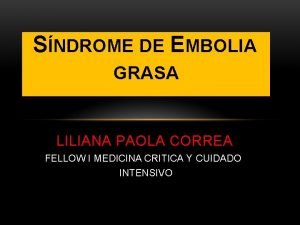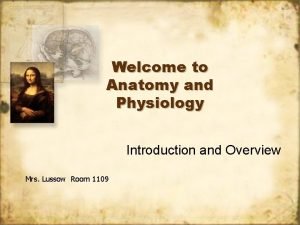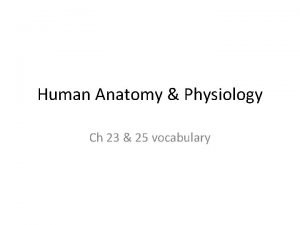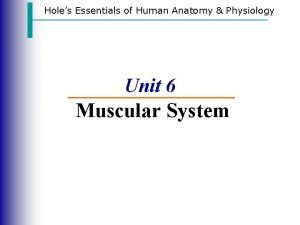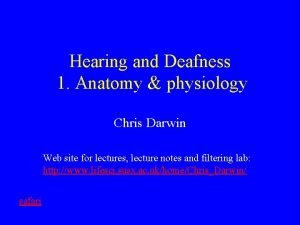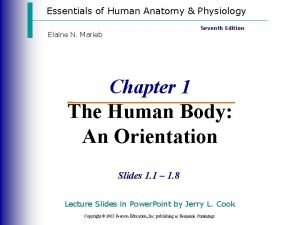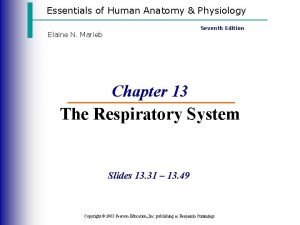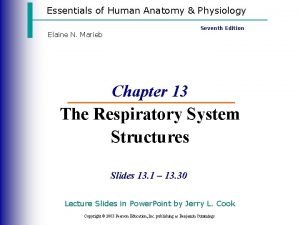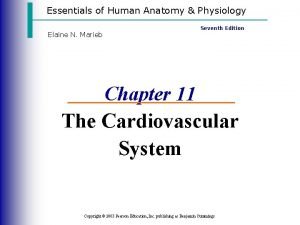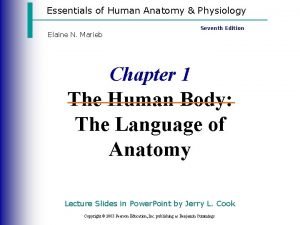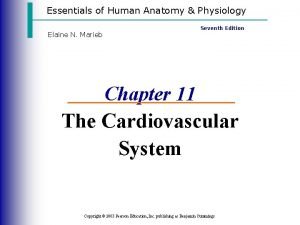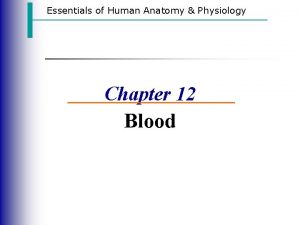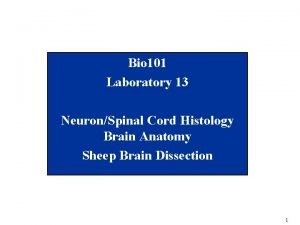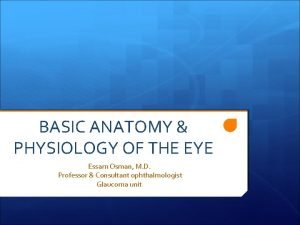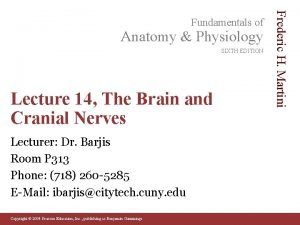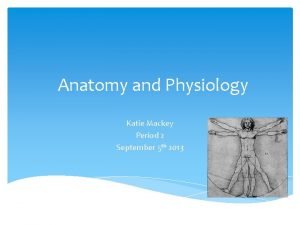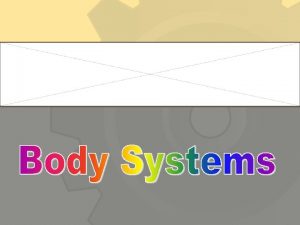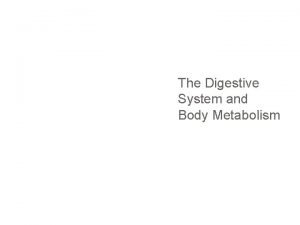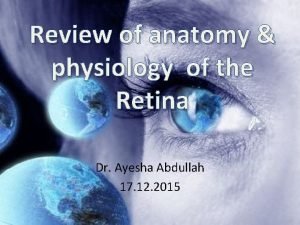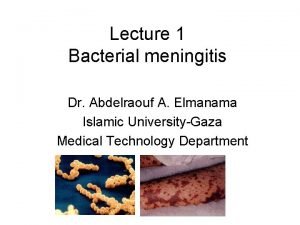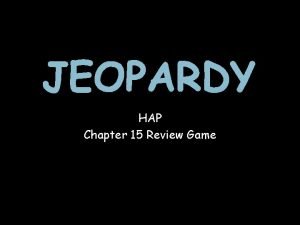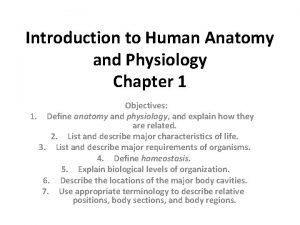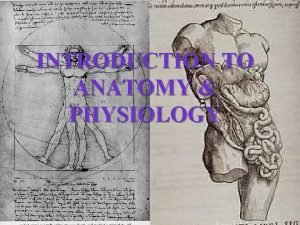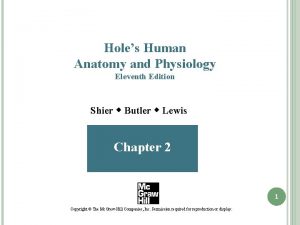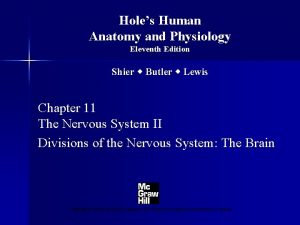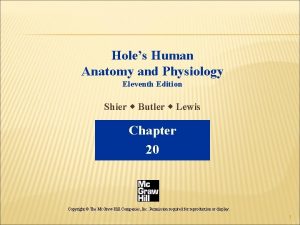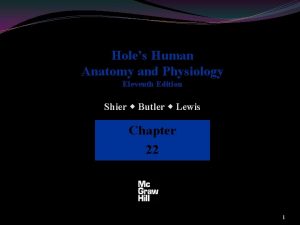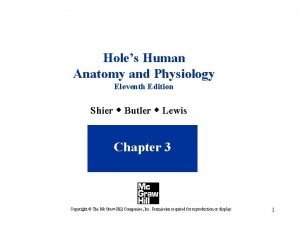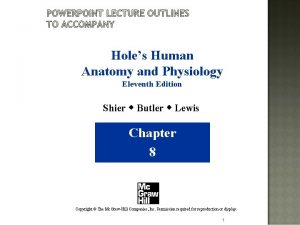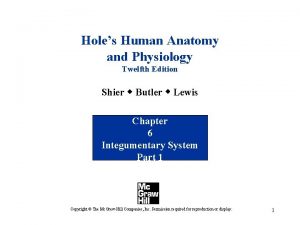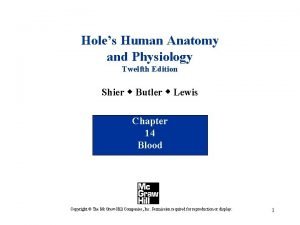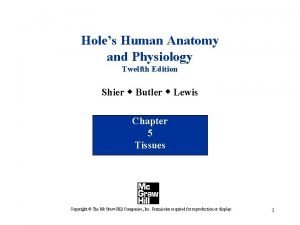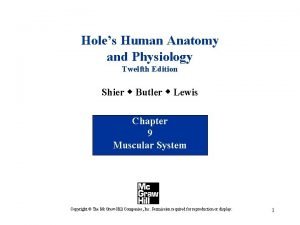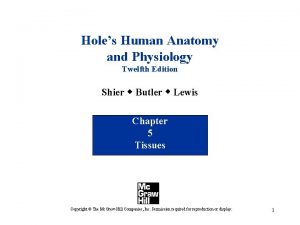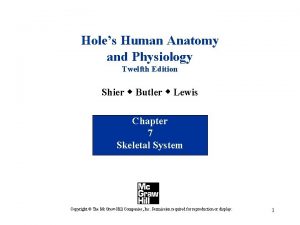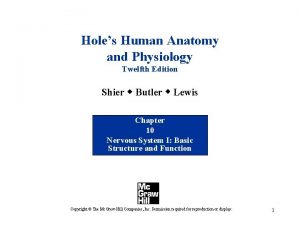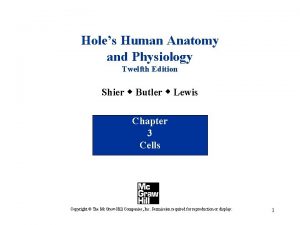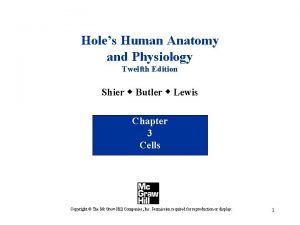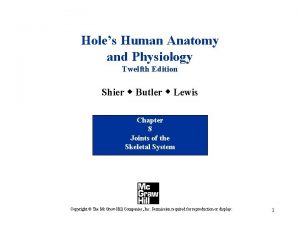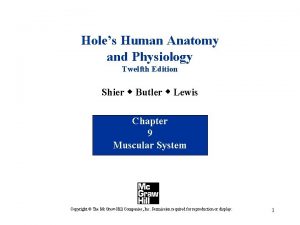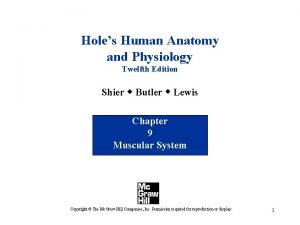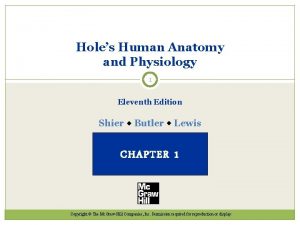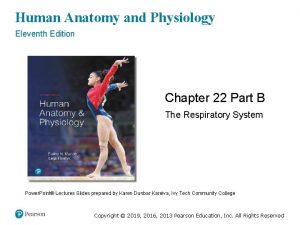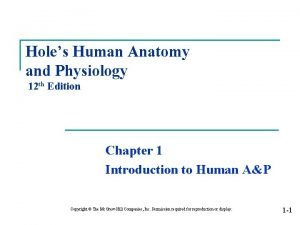Holes Human Anatomy and Physiology Eleventh Edition Shier



























































































- Slides: 91

Hole’s Human Anatomy and Physiology Eleventh Edition Shier w Butler w Lewis Chapter 11 1

Chapter 11: Nervous System II SECTION 1 2

Chapter 11: Nervous System II Meninges • membranes surrounding CNS • protect CNS • three layers 1. dura mater 2. arachnoid mater 3. pia mater 3

Meninges dura mater • Outer most • Tough, white connective tissue • Contains blood vessels and nerves arachnoid mater • Middle layer • Thin, weblike • Sub-arachnoid space below which is filled with cerebrospinal fluid pia mater • Innermost • Thin delicate connective tissues • Many nerves and blood vessels for nourishment • Dips into grooves and contours of brain 4

Meninges of the Spinal Cord Space between vertebrae and dura mater is called epidural space and is filled with loose connective tissue and fat. 5

Epidural used for pain during childbirth 6

Meningitis • infection within the meninges • 2 types – viral and bacterial 7

Meningitis • May be diagnosed by drawing CSF from sub-arachnoid space at the lumbar region in a procedure called a lumbar puncture. This procedure is also called a spinal tap. 8

Major Divisions of the Brain Also classified as: 9

Ventricles • interconnected cavities • lateral ventricles • third ventricle • fourth ventricle • cerebral aqueduct • within cerebral hemispheres and brain stem • continuous with central canal of spinal cord • filled with cerebrospinal fluid (CSF) 10

Cerebrospinal Fluid • secreted by choroid plexus • circulates in: • Ventricles • central canal of spinal cord • subarachnoid space • completely surrounds brain and spinal cord • clear liquid • nutritive and protective • helps maintain stable ion concentrations in CNS 11

Ommaya Reservior

Chapter 11: Nervous System II SECTION 2 13

Spinal Cord • slender column of nervous tissue continuous with brain • extends downward through vertebral canal • begins at level of foramen magnum and terminates near first and second lumbar 14

Cross Section of Spinal Cord 15

Functions of Spinal Cord • center for spinal reflexes • conduit for nerve impulses to and from the brain 16

Reflex Arcs Reflexes – automatic, subconscious responses to stimuli within or outside the body 17

General Components of a Spinal Reflex 18

Tracts of the Spinal Cord • Ascending tracts conduct sensory impulses to the brain • Descending tracts conduct motor impulses from the brain to motor neurons reaching muscles and glands 19

Chapter 11: Nervous System II SECTION 3 20

Brain Major Parts • cerebrum • two hemispheres • basal nuclei • • diencephalon • brainstem • cerebellum Functions • interprets sensations • determines perception • stores memory • reasoning • makes decisions • coordinates muscular movements • regulates visceral activities • determines personality 21

Brain 22

Brain Development Three Major Vesicles 1. Forebrain 2. Midbrain 3. Hindbrain 23

Brain Development 24

Structure of Cerebrum • corpus callosum • connects cerebral hemispheres • convolutions • bumps or gyri • sulci • grooves • longitudinal fissure • separates hemispheres • transverse fissure • separates cerebrum from cerebellum 25

Lobes of Cerebral Hemispheres • Frontal • Parietal • Temporal • Occipital • Insula 26

Functions of the Cerebrum • interpreting impulses • initiating voluntary movements • storing information as memory • retrieving stored information • reasoning • seat of intelligence and personality 27

Functional Regions of Cerebral Cortex – thin layer of gray matter that constitutes the outermost portion of cerebrum; contains 75% of all neurons in nervous system 28

Sensory Areas • Cutaneous Sensory Area • parietal lobe • interprets sensations on skin • Visual Area • occipital lobe • interprets vision • Sensory Area for Taste • near bases of the central sulci • Sensory Area for Smell • arise from centers deep within the cerebrum • Auditory Area • temporal lobe • interprets hearing 29

Sensory Areas 30

Association Areas • regions that are not primary motor or primary sensory areas • widespread throughout the cerebral cortex • analyze and interpret sensory experiences • provide memory, reasoning, verbalization, judgment, emotions 31

Association Areas Frontal Lobe Association Areas • concentrating • planning • complex problem solving Parietal Lobe Association Areas • understanding speech • choosing words to express thought Temporal Lobe Association Areas • interpret complex sensory experiences • store memories of visual scenes, music, and complex patterns Occipital Lobe Association Areas • analyze and combine visual images with other sensory experiences 32

Hemisphere Dominance • The left hemisphere is dominant is most individuals • Dominant hemisphere controls • speech • writing • reading • verbal skills • analytical skills • computational skills • Nondominant hemisphere controls • nonverbal tasks • motor tasks • understanding and interpreting musical and visual patterns • provides emotional and intuitive thought processes 33

Memory Short Term • working memory • closed neuronal circuit • circuit is stimulated over and over • when impulse flow ceases, memory does also • unless it enters long-term memory via memory consolidation Long Term • changes structure or function of neurons • enhances synaptic transmission 34

Motor Areas • Primary Motor Areas • frontal lobes • control voluntary muscles • Broca’s Area • anterior to primary motor cortex • usually in left hemisphere • controls muscles needed for speech • Frontal Eye Field • above Broca’s area • controls voluntary movements of eyes and eyelids 35

Motor Areas 36

Functions of the Cerebral Lobes 37

Basal Nuclei • masses of gray matter • deep within cerebral hemispheres • caudate nucleus, putamen, globus pallidus • produce dopamine • control certain muscular activities • primarily by inhibiting motor functions 38

Diencephalon • between cerebral hemispheres and above the brainstem • surrounds third ventricle • • thalamus hypothalamus optic tracts optic chiasma infundibulum posterior pituitary mammillary bodies pineal gland 39

Diencephalon Thalamus • gateway for sensory impulses heading to cerebral cortex • receives all sensory impulses (except smell) • channels impulses to appropriate part of cerebral cortex for interpretation Hypothalamus • maintains homeostasis by regulating visceral activities • links nervous and endocrine systems 40

Diencephalon Limbic System Consists of • portions of frontal lobe Functions • portions of temporal lobe • controls emotions • produces feelings • hypothalamus • interprets sensory impulse • thalamus • basal nuclei • other deep nuclei 41

Brain Stem Three Parts 1. Midbrain 2. Pons 3. Medulla Oblongata 42

Midbrain • between diencephalon and pons • contains bundles of fibers that join lower parts of brainstem and spinal cord with higher part of brain • cerebral aqueduct • cerebral peduncles – bundles of nerve fibers • corpora quadrigemina – centers for visual and auditory reflexes 43

Pons • rounded bulge on underside of brainstem • between medulla oblongata and midbrain • helps regulate rate and depth of breathing • relays nerve impulses to and from medulla oblongata and cerebellum 44

Medulla Oblongata • enlarged continuation of spinal cord • conducts ascending and descending impulses between brain and spinal cord • contains cardiac, vasomotor, and respiratory control centers • contains various nonvital reflex control centers (coughing, sneezing, swallowing, vomiting) 45

Reticular Formation • complex network of nerve fibers scattered throughout the brain stem • extends into the diencephalon • connects to centers of hypothalamus, basal nuclei, cerebellum, and cerebrum • filters incoming sensory information • arouses cerebral cortex into state of wakefulness 46

Types of Sleep Slow Wave Rapid Eye Movement (REM) • non-REM sleep • paradoxical sleep • person is tired • some areas of brain • decreasing activity of active reticular system • heart and respiratory • restful rates irregular • dreamless • dreaming occurs • reduced blood pressure and respiratory rate • ranges from light to heavy • alternates with REM 47

Cerebellum • inferior to occipital lobes • posterior to pons and medulla oblongata • two hemispheres • vermis connects hemispheres • cerebellar cortex – gray matter • arbor vitae – white matter • cerebellar peduncles – nerve fiber tracts • dentate nucleus – largest nucleus in cerebellum • integrates sensory information concerning position of body parts • coordinates skeletal muscle activity • maintains posture 48

Major Parts of the Brain 49

Chapter 11: Nervous System II SECTION 4 50

Peripheral Nervous System Subdivided into 2 branches: 1. Sensory Divison 2. Motor Divison 51

PNS: Motor Division Subdivided into 2 branches: 1. Somatic NS – from CNS to skin and skeletal muscles 2. Autonomic NS – from CNS to smooth muscle, cardiac muscle and endocrine glands 52

Peripheral Nervous System Includes: 1. Cranial nerves arising from the brain 2. Spinal nerves arising from the spinal cord Both have • Somatic fibers connecting to the skin and skeletal muscles • Autonomic fibers connecting to viscera 53

Nerve Fiber Classification A nerve is a cord-like bundle of axons wrapped in connective tissue. There are 3 types of nerve fibers. • Sensory Nerves – conduct impulses into brain or spinal cord • Motor Nerves – conduct impulses to muscles or glands • Mixed Nerves – contain both sensory nerve fibers and motor nerve fibers; most nerves 54

Nerve Fiber Classification Two Subdivisions of spinal and cranial nerves: These are the 2 subdivisions of Sensory division of PNS 1. General – fibers associated with general structures such as the skin, skeletal muscles, glands, and viscera. 2. Special – fibers associated with more specialized structures such as eyes and ears 55

Nerve Fiber Classification General somatic efferent fibers • carry motor impulses from CNS to skeletal muscles General visceral efferent fibers • carry motor impulses away from CNS to smooth muscles and glands General somatic afferent fibers • carry sensory impulses to CNS from skin and skeletal muscles General visceral afferent fibers • carry sensory impulses to CNS from blood vessels and internal organs 56

Nerve Fiber Classification Special somatic efferent fibers • carry motor impulses from brain to muscles used in chewing, swallowing, speaking, and forming facial expressions Special visceral afferent fibers • carry sensory impulses to brain from olfactory and taste receptors Special somatic afferent fibers • carry sensory impulses to brain from receptors of sight, hearing, and equilibrium 57

Cranial Nerves 58

Cranial Nerves 12 pairs of cranial nerves 2 pair to/from forebrain 10 pairs to/from brain stem 59

Cranial Nerves I. Olfactory – sense of smell - sensory only II. Optic – sense of vision - sensory only III. Oculomotor – innervates eye muscles - motor only IV. Trochlear – innervates eye muscles - motor only V. Trigeminal – largest sensory from face motor to chewing muscles mixed VI. Abducens – innervates eye muscles - motor only 60

Cranial Nerves VII. Facial – innervates muscles of facial expression sensory taste - mixed VIII. Vestibulocochlear – sense of hearing and equilibrium - sensory only IX. Glossopharyngeal – moves tongue and pharynx muscles - mixed X. Vagus – innervates visceral smooth muscle - mixed XI. Accessory – innervates neck muscles - motor only XII. Hypoglossal – moves tongue - motor only 61

Spinal Nerves • ALL mixed nerves • 31 pairs • 8 cervical • 12 thoracic • 5 lumbar • 5 sacral • 1 coccygeal 62

Spinal Nerves Dorsal root (posterior or sensory root) • axons of sensory neurons in the dorsal root ganglion Dorsal root ganglion • cell bodies of sensory neurons whose axons conduct impulses inward from peripheral body parts 63

Spinal Nerves Ventral root (anterior or motor root) • axons of motor neurons whose cell bodies are in spinal cord Spinal nerve • union of ventral root and dorsal root 64

Nerve Plexus Nerve plexus – complex networks formed by anterior branches of spinal nerves; fibers of various spinal nerves are sorted and recombined Cervical Plexus - contribute to neck & phrenic (diaphragm) nerves Brachial Plexus – upper limbs Lumbar Plexus – anterior and medial thigh Sacral Plexus – posterior lower limb 65

Somatic NS vs. Autonomic NS Somatic NS One motor neuron No ganglia Uses acetylcholine Effector = skeletal muscle Autonomic NS Two motor neurons Synapse between neurons occur within a ganglion Effectors = smooth muscle, cardiac muscle, & glands 2 divisions: ○ Sympathetic ○ Parasympathetic 66

Autonomic Nervous System • functions without conscious effort • controls visceral activities • regulates smooth muscle, cardiac muscle, and glands • efferent fibers typically lead to ganglia outside CNS Two Divisions • sympathetic – prepares body for fight or flight situations • parasympathetic – prepares body for resting and digesting activities 67

Sympathetic Division Preganglionic neuron = short Postganglionic neuron = long Norepinephrine is the neurotransmitter used. 68

Life-Span Changes • Brain cells begin to die before birth • Over average lifetime, brain shrinks 10% • Most cell death occurs in temporal lobes • By age 90, frontal cortex has lost half its neurons • Number of dendritic branches decreases • Decreased levels of neurotransmitters • Fading memory • Slowed responses and reflexes • Increased risk of falling • Changes in sleep patterns that result in fewer sleeping hours 69

Clinical Application Cerebral Injuries and Abnormalities Concussion • brain jarred against cranium • loss of consciousness • temporary loss of memory • mental cloudiness • headache • recovery usually complete Cerebrovascular Accident • stroke • sudden interruption in blood flow • brain tissues die Cerebral Palsy • motor impairment at birth • caused by blocked cerebral blood vessels during development • seizures • learning disabilities 70

End here – rest are extras 71

Parasympathetic Division Preganglionic neuron = long Postganglionic neuron = short Acetylcholine is the neurotransmitter used. 72

Autonomic Nerve Fibers • all are neurons are motor (efferent) • preganglionic fibers • axons of preganglionic neurons • neuron cell bodies in CNS • postganglionic fibers • axons of postganglionic neurons • neuron cell bodies in ganglia 73

Sympathetic Division • thoracolumbar divison – location of preganglionic neurons • preganglionic fibers leave spinal nerves through white rami and enter paravertebral ganglia • paraverterbral ganglia and fibers that connect them make up the sympathetic trunk 74

Sympathetic Division • postganglionic fibers extend from sympathetic ganglia to visceral organs • postganglionic fibers usually pass through gray rami and return to a spinal nerve before proceeding to an effector • Exception: preganglionic fibers to adrenal medulla do not synapse with postganglionic neurons 75

Parasympathetic Division • craniosacral division – location of preganglionic neurons • ganglia are near or within various organs • terminal ganglia • short postganglionic fibers • continue to specific muscles or glands • preganglionic fibers of the head are included in nerves III, VII, and IX • preganglionic fibers of thorax and abdomen are parts of nerve X 76

Autonomic Neurotransmitters Cholinergic Fibers • release acetylcholine • preganglionic sympathetic and parasympathetic fibers • postganglionic parasympathetic fibers Adrenergic Fibers • release norepinephrin e • most postganglionic 77

Actions of Autonomic Neurotransmitters • depend on receptors in the membrane Cholinergic receptors • bind to acetlycholine • muscarinic • excitatory • slow • nicotinic • excitatory • rapid Adrenergic Receptors • bind to epinephrine and norepinephrine • alpha and beta • both elicit different responses on various effectors 78

Actions of Autonomic Neurotransmitters Insert figure 11. 39 79

Control of Autonomic Activity • Controlled largely by CNS • Medulla oblongata regulates cardiac, vasomotor and respiratory activities • Hypothalamus regulates visceral functions, such as body temperature, hunger, thirst, and water and electrolyte balance • Limbic system and cerebral cortex control emotional responses 80

Cranial Nerves I and II Olfactory (I) • sensory • fibers transmit impulses associated with smell Optic (II) • sensory • fibers transmit impulses associated with vision 81

Cranial Nerves III and IV Oculomotor (III) • some sensory • proprioreceptors • primarily motor • motor impulses to muscles that • raise eyelids • move the eyes • focus lens • adjust light entering eye Trochlear (IV) • some sensory • proprioreceptors • primarily motor • motor impulses to muscles that move the eyes 82

Cranial Nerve V Trigeminal (V) • mixed • opthalmic division • sensory from surface of eyes, tear glands, scalp, forehead, and upper eyelids • maxillary division • sensory from upper teeth, upper gum, upper lip, palate, and skin of face • mandibular division • sensory from scalp, skin of jaw, lower teeth, lower gum, and lower lip • motor to muscles of mastication and muscles in floor of mouth 83

Cranial Nerves VI and VII Abducens (VI) • primarily motor • motor impulses to muscles that move the eyes • some sensory with proprioreceptors Facial (VII) • mixed • sensory from taste receptors • motor to muscles of facial expression, tear glands, and salivary glands 84

Cranial Nerves VIII and IX Vestibulocochlear (VIII) • sensory • vestibular branch • sensory from equilibrium receptors of ear • cochlear branch • sensory from hearing receptors Glossopharyngeal (IX) • mixed • sensory from pharynx, tonsils, tongue, and carotid arteries • motor to salivary glands and muscles of pharynx 85

Cranial Nerve X Vagus (X) • mixed • somatic motor to muscles of speech and swallowing • autonomic motor to viscera of thorax and abdomen • sensory from pharynx, larynx, esophagus, and viscera of thorax and abdomen 86

Cranial Nerves XI and XII Accessory (XI) • primarily motor • cranial branch • motor to muscles of soft palate, pharynx, and larynx • spinal branch • motor to muscles of neck, and back; some proprioreceptor Hypoglossal (XII) • primarily motor • motor to muscles of the tongue; some proprioreceptor 87

Cervical Plexuses Nerve plexus – complex networks formed by anterior branches of spinal nerves; fibers of various spinal nerves are sorted and recombined Cervical Plexus • formed by anterior branches of C 1 -C 4 • lies deep in the neck • supply muscles and skin of the neck • C 3 – C 5 contribute to phrenic nerves 88

Brachial Plexuses • C 5 -T 1 • lies deep within shoulders • musculocutaneous nerves • supply muscles of anterior arms and skin of forearms • ulnar and median nerves • supply muscles of forearms and hands • supply skin of hands • radial nerves • supply posterior muscles of arms and skin of forearms and hands • axillary nerves • supply muscles and skin of anterior, lateral, and posterior arms 89

Lumbosacral Plexuses • T 12 – S 5 • extend from lumbar region into pelvic cavity • obturator nerves • supply motor impulses to adductors of thighs • femoral nerves • supply motor impulses to muscles of anterior thigh and sensory impulses from skin of thighs and legs • sciatic nerves • supply muscles and skin of thighs, legs, 90

Plexuses 91
 Holes essential of human anatomy and physiology
Holes essential of human anatomy and physiology 3 layers of muscle
3 layers of muscle Uterus perimetrium
Uterus perimetrium Holes anatomy and physiology chapter 1
Holes anatomy and physiology chapter 1 Anatomy and physiology ninth edition
Anatomy and physiology ninth edition Management eleventh edition
Management eleventh edition Management eleventh edition stephen p robbins
Management eleventh edition stephen p robbins Management eleventh edition
Management eleventh edition Management eleventh edition stephen p robbins
Management eleventh edition stephen p robbins Waistline
Waistline Anterior posterior distal proximal
Anterior posterior distal proximal Chapter 2 human reproductive anatomy and physiology
Chapter 2 human reproductive anatomy and physiology Peter shier
Peter shier Criterios de lindeque
Criterios de lindeque Shy степени сравнения
Shy степени сравнения Human anatomy fifth edition
Human anatomy fifth edition Human anatomy fifth edition
Human anatomy fifth edition Physiology of sport and exercise 5th edition
Physiology of sport and exercise 5th edition Eleventh 5 year plan
Eleventh 5 year plan Eleventh 5 year plan
Eleventh 5 year plan 11th five year plan
11th five year plan For his eleventh birthday elvis presley
For his eleventh birthday elvis presley Respiratory physiology
Respiratory physiology Tattoo anatomy and physiology
Tattoo anatomy and physiology International anatomy olympiad
International anatomy olympiad Specialized stems examples
Specialized stems examples Anatomy and physiology bone
Anatomy and physiology bone Duodenal ulcer anatomy
Duodenal ulcer anatomy Sheep liver lobes
Sheep liver lobes Hypogastric region
Hypogastric region Iliac regions
Iliac regions The blood anatomy and physiology
The blood anatomy and physiology Chapter 14 anatomy and physiology
Chapter 14 anatomy and physiology Http://anatomy and physiology
Http://anatomy and physiology Appendectomy anatomy and physiology
Appendectomy anatomy and physiology Aohs foundations of anatomy and physiology 1
Aohs foundations of anatomy and physiology 1 Aohs foundations of anatomy and physiology 1
Aohs foundations of anatomy and physiology 1 Anatomical planes
Anatomical planes Anatomy and physiology chapter 8 special senses
Anatomy and physiology chapter 8 special senses Chapter 13 anatomy and physiology of pregnancy
Chapter 13 anatomy and physiology of pregnancy Unit 26 agriscience
Unit 26 agriscience Science olympiad anatomy and physiology 2020 cheat sheet
Science olympiad anatomy and physiology 2020 cheat sheet Anatomy and physiology chapter 2
Anatomy and physiology chapter 2 Degluttination
Degluttination Anatomy and physiology of diabetes
Anatomy and physiology of diabetes Heat and cold
Heat and cold Anatomy and physiology coloring workbook chapter 14
Anatomy and physiology coloring workbook chapter 14 Chapter 10 blood anatomy and physiology
Chapter 10 blood anatomy and physiology Aohs foundations of anatomy and physiology 1
Aohs foundations of anatomy and physiology 1 Aohs foundations of anatomy and physiology 1
Aohs foundations of anatomy and physiology 1 Anatomy and physiology
Anatomy and physiology Anatomy and physiology chapter 15
Anatomy and physiology chapter 15 Cornell notes for anatomy and physiology
Cornell notes for anatomy and physiology Necessary life functions anatomy and physiology
Necessary life functions anatomy and physiology Anatomy and physiology unit 7 cardiovascular system
Anatomy and physiology unit 7 cardiovascular system Gi tract histology
Gi tract histology Anatomy and physiology
Anatomy and physiology The speed at which the body consumes energy
The speed at which the body consumes energy Aohs foundations of anatomy and physiology 1
Aohs foundations of anatomy and physiology 1 Chapter 1 an introduction to anatomy and physiology
Chapter 1 an introduction to anatomy and physiology Human physiology exam 1
Human physiology exam 1 Welcome to anatomy and physiology
Welcome to anatomy and physiology Anatomy and physiology of the foot
Anatomy and physiology of the foot Skin cancer
Skin cancer Pancreas anatomy histology
Pancreas anatomy histology Anatomy and physiology vocabulary
Anatomy and physiology vocabulary Anatomy and physiology
Anatomy and physiology Biceps muscle names
Biceps muscle names Anatomy and physiology
Anatomy and physiology Organ orientation
Organ orientation Anatomy and physiology
Anatomy and physiology Anatomy and physiology
Anatomy and physiology Thyroid anatomy
Thyroid anatomy Anatomy and physiology
Anatomy and physiology Anatomy and physiology
Anatomy and physiology Anatomy and physiology
Anatomy and physiology Anatomy and physiology
Anatomy and physiology Figure 10-1 blood
Figure 10-1 blood Anatomy histology
Anatomy histology Anatomy and physiology of the eye
Anatomy and physiology of the eye Telencephalon
Telencephalon Irn.org anatomy and physiology
Irn.org anatomy and physiology Anatomy and physiology body parts
Anatomy and physiology body parts Unit 26 animal anatomy physiology and nutrition
Unit 26 animal anatomy physiology and nutrition Figure 14-1 digestive system
Figure 14-1 digestive system Anatomy and physiology of the retina
Anatomy and physiology of the retina Animal tissue
Animal tissue Anatomy and physiology of meningitis ppt
Anatomy and physiology of meningitis ppt Jeopardy anatomy and physiology game
Jeopardy anatomy and physiology game Homeostasis
Homeostasis Anatomy and physiology
Anatomy and physiology Respiratory system in humans
Respiratory system in humans













